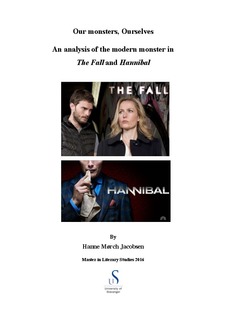| dc.description.abstract | The monster has been a popular figure in Western society for centuries, as a notion that has both fascinated and frightened its members. The aim of this thesis is to investigate the modern, moral monster that exists within contemporary Western society, and how this is presented in two modern texts. The chosen texts for the analysis in the thesis are the TV-series The Fall and Hannibal, which both deals with the notion of the moral monster through the figure of the serial killer.
Throughout time, the monster has been used as a symbol of warning in fairy tales, or cautionary tales. One of the most popular cautionary tales in Western culture is the story of “Little Red Riding Hood”, which follows the narrative structure of fairy tales and presents a damsel in distress and a big, bad wolf who threatens her safety. This thesis sets to analyse how the two texts The Fall and Hannibal can also function as modified forms of the cautionary tale. It will also examine whether the serial killers in the TV-series can be seen as a modern kind of ‘wolf’, who lurks in the contemporary society.
This thesis also addresses the notion of ‘otherness’ and how this is presented and defined in contemporary society. As a result of its abnormal features, the monster can be seen as the absolute ‘other’, and helps us creating a sense of ‘self’ by presenting a binary opposite to this. Since the monster is created as a result of the anxieties that exist within a culture, it can say something about the aspects we wish to get rid of, as well as distance ourselves from. As a result, it can also say something about the contemporary Western society, and us who live within it. | nb_NO |

